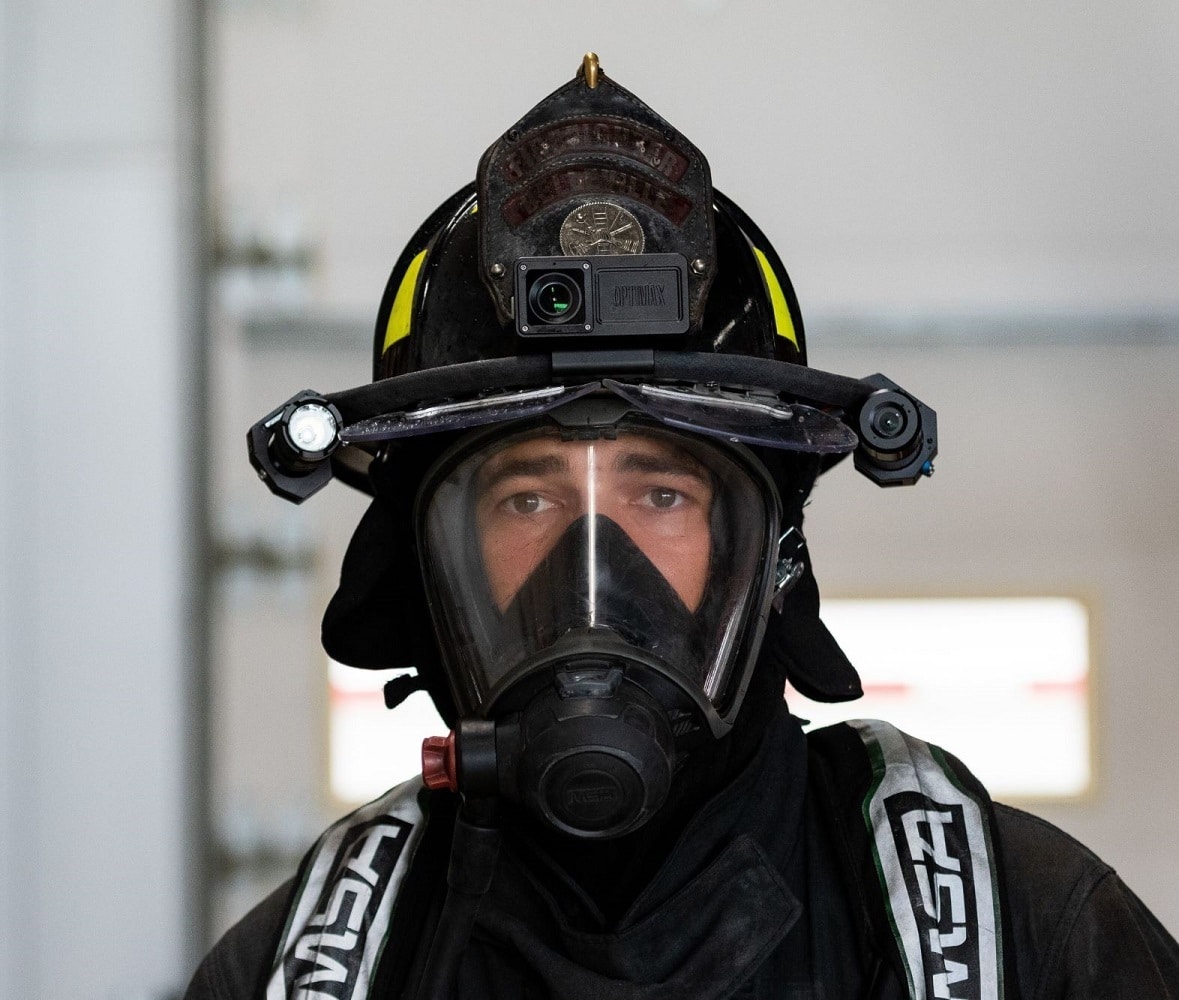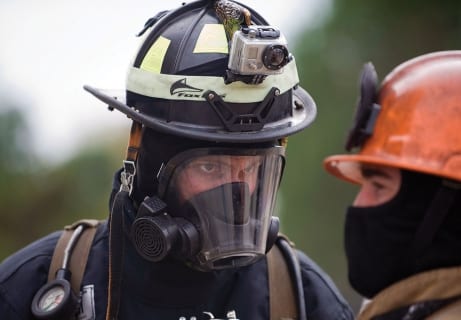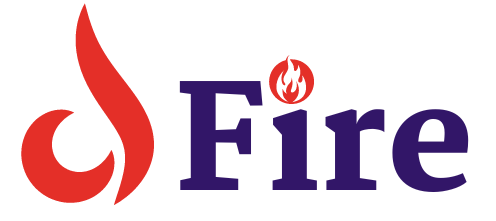Firefighter helmet cameras are vital tools for enhancing situational awareness and post-incident analysis. They enable real-time recording from a first-person perspective.
Firefighter helmet cameras provide an invaluable record of operations, capturing video footage that helps in training, investigation, and improving tactics. These compact, durable devices are designed to withstand the extreme conditions firefighters face, such as high temperatures and water exposure.
With advancements in technology, these cameras often feature night vision, thermal imaging, and hands-free operation. By documenting incidents, helmet cameras offer a unique viewpoint that aids in reviewing protocols and can contribute to legal and educational purposes. As firefighting strategies evolve, helmet cameras continue to play a crucial role in the safety and efficiency of fire services, augmenting accountability, and fostering continuous learning.

Credit: www.amazon.com
Evolution Of The Firefighter Helmet Camera
The firefighting battlefield has evolved with technology. One standout advancement is the helmet camera. It has changed the way firefighters approach emergencies. Let’s dive into this evolution.
From Bulky Gear To High-tech Helper
Helmet cameras have transformed from cumbersome accessories to sleek, vital tools. Early versions were heavy and clunky, hindering movement. Today’s cameras are light and barely noticeable.
- Original cameras: Added significant weight to helmets.
- Modern cameras: Compact and lightweight.
They now secure easily to helmets. Firefighters can move freely and focus on their crucial work.
Technological Advances In Helmet Cameras
Tech improvements in firefighter cameras have been game-changing. Better video quality and smarter features make them indispensable.
Current cameras boast impressive specs:
| Feature | Benefit |
|---|---|
| High-Definition Recording | Clearer footage for review and training. |
| Night Vision | Improved visibility in dark environments. |
| Thermal Imaging | Detects heat sources through smoke. |
| Live Streaming | Real-time situational awareness for teams. |
These advances aid firefighters in making informed decisions quickly. They can also share critical information in real-time.

Credit: firecam.com
Need For Visual Recording In Firefighting
The need for visual recording in firefighting is essential. Helmet cameras play a critical role. They capture real-time footage of fire incidents. This footage serves many purposes. It assists in review and training. It provides evidence for investigations. Visual recordings also enhance safety. Firefighters make better decisions with more information.
Training And Tactical Advantages
- Review operations: Teams watch footage to improve strategies.
- Learning tool: New firefighters learn from real scenarios.
- Improved techniques: Captured video shows effective tactics.
- Incident analysis: Teams analyze decisions and outcomes.
Helmet cameras bring undeniable tactical benefits. Visual aids help hone firefighting skills. They lead to safer and smarter approaches in emergencies.
Accountability And Legal Protection
- Document actions: Cameras capture on-scene decisions and actions.
- Evidence collection: Video recordings can validate operations.
- Dispute resolution: Footage can clarify contentious situations.
- Policy adherence: Videos ensure procedures are followed.
Visual records provide accountability. Helmets with cameras add a layer of legal safety. They show a truthful depiction of events. This can protect firefighters during legal inquiries.
Design And Durability: Made For Extremes
Firefighter helmet cameras must survive where few can—the heart of the inferno. Crafted for heroes, these cameras are a marvel of technology and engineering. They endure the unimaginable, from scorching temperatures to devastating impacts. Let’s delve into what makes these devices so resilient and reliable in the most critical moments.
Material And Build
The foundation of a firefighter helmet camera is its material. The camera’s outer shell often utilizes high-grade thermoplastics or metal alloys. These materials are chosen for their high melting points and remarkable strength. Such a build ensures the camera remains intact, functional, and securely attached to the helmet even amidst a raging firestorm.
- Lightweight Design: Ensures comfort and ease of movement.
- Secure Mounting: Cameras feature robust attachment systems.
Resistance To Heat And Impact
A firefighter’s environment is one of the most challenging. Helmet cameras are designed to withstand not just high temperatures but also significant impacts.
| Feature | Benefit |
|---|---|
| Heat Resistance | Survives direct flame contact and radiant heat. |
| Impact Resilience | Continues recording even after falls or collisions. |
Special coatings prevent lens damage. Internal components are encased to protect against smoke and water. Such resistance allows firefighters to review footage for training or investigation post-mission.
Capturing The Frontlines: Camera Features
Brave firefighters step into the unknown every day. Their helmet cameras are their eyes, recording heroism in the heart of danger. Each device packs features meant for the high-stakes environment of firefighting. Explore the vital facets of these indispensable tools.
High-definition Video Quality
Clarity in chaos is crucial. Firefighter helmet cameras boast high-definition video quality. Footage captures crisp, clear details even amidst smoke and debris. Such clarity aids in post-fire analysis and training, offering a true-to-life account of events.
Night Vision And Thermal Imaging
Unseen hazards come to light with night vision. Darkness and smoke cannot hide the perils. Thermal imaging elevates safety, highlighting heat signatures that pinpoint fires, victims, and team members. This tech is vital for efficient navigation and rescue in low-visibility conditions.
Adapting To The Call: Wearability And Comfort
Firefighters charge into danger to save lives and protect property. They need gear that won’t slow them down. A firefighter helmet camera should be as tough and ready as they are. Let’s explore how these cameras fit into their critical mission.
Helmet Integration
A helmet camera must fit seamlessly with the firefighter’s gear. It should feel like it’s part of the helmet itself. Here’s how the best cameras blend in:
- Clip-on designs that avoid helmet modification
- Cameras with a low profile to prevent snagging
- Adjustable angles for a perfect line of sight
Ease Of Operation During Emergencies
When every second counts, a firefighter’s camera must work flawlessly. The following points make operation easy:
- Single-button start for quick activation
- Large buttons to use with gloves on
- Intuitive placement to reduce distractions
Storage And Data Management
Firefighter helmet cameras play a crucial role in capturing on-scene footage. This data can help in training, incident review, and legal proceedings. Managing this visual evidence securely and efficiently is paramount. Let’s explore the best practices for storage and data management that keep this vital information safe and accessible.
Secure Storage Solutions
Protecting the data collected by firefighter helmet cameras requires robust storage solutions.
- Encryption keeps video data safe from unauthorized access.
- Cloud storage options offer remote accessibility and large storage capacity.
- On-site servers provide full control over data storage and security.
Choosing the right platform depends on a department’s budget, size, and security needs.
Efficient Data Retrieval And Sharing
After ensuring data is stored securely, it’s vital to have quick access for analysis and sharing.
- Indexing files by date, incident, or team allows easy searchability.
- Having a user-friendly interface ensures rapid retrieval during critical reviews.
- Controlled sharing options protect data integrity while facilitating collaboration.
Clear protocols for data handling assure efficient and responsible data use.
Ethical Considerations And Privacy Issues
The use of firefighter helmet cameras introduces complex ethical considerations and privacy issues. Firefighters often encounter highly sensitive situations. As these devices capture images and audio at the scene, they also raise questions about the rights of the individuals involved. Let’s delve into two critical aspects: the need for consent before recording and the management of sensitive footage.
Consent To Record
Recording during emergencies needs careful thought. Firefighter cameras roll into action where events unfold rapidly. Securing consent in such scenarios is challenging. Yet, respecting individuals’ privacy remains paramount. Here are key points to consider:
- Define clear guidelines for when and where recording is permissible.
- Ensure all team members understand the importance of consent.
- Balance the need for documentation with privacy rights.
- Adopt practices to seek consent, where feasible, without impeding response efforts.
Handling Sensitive Footage
Managing the footage captured is a serious responsibility. Footage can include victims, bystanders, or private property. Strict protocols must govern its handling. Consider these steps:
- Limit access to only those who need to view the footage.
- Establish secure storage systems to prevent unauthorized distribution.
- Implement strict data retention policies to ensure footage isn’t kept longer than necessary.
- Apply guidelines for blurring faces and other identifying features when sharing footage.
Impact On Heroes’ Legacy
Firefighter Helmet Cameras serve more than a functional purpose in high-risk environments. They capture the essence of bravery, sculpting a timeless legacy for our firefighting heroes. Let’s uncover how these innovative tools are impacting the narratives of our lifesavers.
Humanizing Firefighters
In the rush of emergency calls and life-saving actions, firefighters are often seen as figures of invincible strength. Helmet cameras change this perception, showcasing the very human emotions and decisions they face. We see their quick thinking, hear their supportive teamwork, and feel the intensity of their missions. These raw moments, caught on camera, shed new light on the valiant yet very human spirit of our firefighters. This visual narrative vividly portrays their dedication and compassion, which often go unseen.
Documenting Heroism For Posterity
The heroism displayed by firefighters does not fade with the flames they extinguish. Helmet cameras serve as a digital archive, preserving their courageous acts for future generations. Each frame tells a story of valor, creating a historical record that will inspire and educate.
- Real-life heroes: Footage can be used to teach aspiring firefighters, demonstrating real-world scenarios.
- Educational tool: Stories of bravery become part of training programs, enhancing learning through visual experience.
- Memorializing service: Captured moments ensure that the commitment of firefighters to saving lives is never forgotten.
By chronicling these stories of bravery, helmet cameras contribute to a growing repository of heroism, creating an enduring legacy for firefighters everywhere.
The Future Of Helmet Cameras In Firefighting
Technology shapes the future of firefighting. Firefighter helmet cameras are no exception. They’ve become vital tools in battling blazes and saving lives. With advanced features on the way, these cameras are about to transform the firefighting landscape. Sit tight as we dive into the innovations set to redefine safety and efficiency for heroes in helmets.
Innovations On The Horizon
Exciting technological leaps will make firefighter helmet cameras smarter. Here’s a sneak peek:
- Improved Visibility: Expect cameras with night vision and thermal imaging.
- Robust Durability: Future models will resist extreme heat and impact.
- Longer Battery Life: Cameras will last entire shifts without recharging.
Integration With Augmented Reality
Augmented reality (AR) will enhance how firefighters see the world. Imagine a helmet camera that not only shows the fire but also overlays vital data:
| Feature | Function |
|---|---|
| Building Layouts | Displays blueprints in real-time. |
| Hazard Identification | Highlights dangers like gas leaks. |
| Victim Locations | Guides rescuers to those in need. |

Credit: www.samatters.com
Real-life Stories: Helmet Cameras In Action
Firefighters navigate smoke-filled rooms and raging flames, a challenge for anyone. Helmet cameras, or ‘helmet cams’, offer us a glimpse into these tense scenarios. They provide real-time footage from the firefighter’s perspective. Through this technology, we gain insights into the critical decisions made during rescues. Let’s explore some of the gripping real-life incidents where helmet cams played a pivotal role.
Case Studies Of Rescues
Helmet cams have not just changed the game in firefighting tactics, but also in life-saving moments. Here are two cases:
- A trapped family on the second floor: Footage shows firefighters navigating through dense smoke to rescue a family. The helmet cam captured every crucial step to safety.
- A colleague falls through the floor: A sudden floor collapse is seen through a helmet cam. The video displays an instant reaction to secure the fallen firefighter and ensure their extraction.
These cameras yielded valuable lessons for future rescues.
Insights From Firefighters
Helmet cam footage is instrumental for training and debriefing sessions. It helps analyze decision-making in the heat of the moment. Firefighters express how these cams:
- Boost training: Recruits learn from real scenarios, enhancing their preparedness.
- Improve communication: Teams review footage to refine in-mission communication strategies.
- Enhance equipment usage: Reviewing footage leads to better use of tools under extreme conditions.
The first-hand experiences shared through helmet cams have undeniably contributed to saving more lives.
Frequently Asked Questions
What Is The Best Camera For Firefighting?
The best camera for firefighting is typically a thermal imaging camera, like the FLIR K65, designed to withstand extreme heat and identify hot spots through smoke and darkness.
Can You Take A Gopro Into A Fire?
Yes, a GoPro can be taken into a fire, but it requires a protective housing to withstand high temperatures and prevent damage. Always follow safety guidelines and use GoPro’s official heat-resistant accessories.
Are Helmet Cameras Safe?
Helmet cameras are generally safe, but ensure secure mounting to avoid impairing helmet integrity. Check local laws for any restrictions on their use while riding.
What Color Helmets Do Fire Marshals Wear?
Fire marshals typically wear white helmets to distinguish their role at a fire scene.
Conclusion
Embracing the revolution in firefighting, helmet cameras stand as a beacon of safety and accountability. They offer a unique perspective, invaluable for training and incident analysis. Ensuring every moment is captured, these devices prove to be indispensable tools for firefighters.
As technology advances, so will their capacity to save lives and protect property, reinforcing their place as a modern firefighting staple. Choose a firefighter helmet camera to illuminate the path to greater efficacy and foresight in emergency response.

I’m Abdus Sobur, a highly skilled and professional Fire Safety Officer with a passion for safeguarding lives and property. Over the course of my career, I’ve conducted numerous successful fire safety audits, earning a reputation for excellence in ensuring public safety.
In addition to my role as a Fire Safety Officer, I’m also dedicated to raising awareness about the importance of fire safety. Through my blog, I share insights into the functions of different fire safety equipment, aiming to empower individuals with the knowledge they need to protect themselves and their communities.
I’m driven by a deep commitment to promoting fire safety awareness and preventing fire-related incidents.

